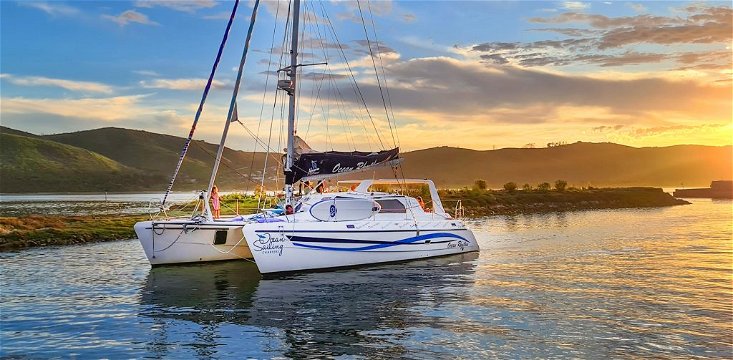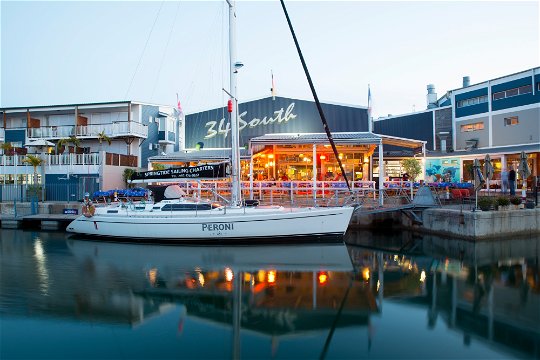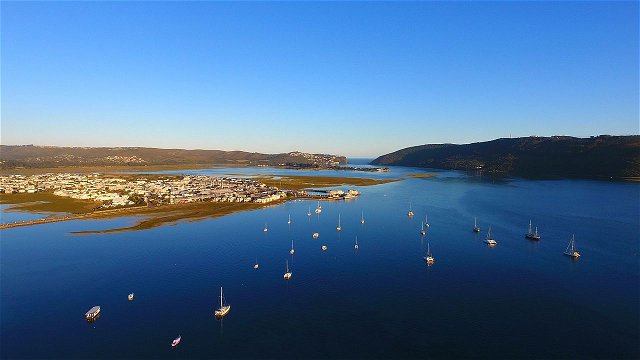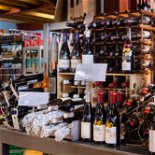What are the purposes and functions of decanters and aerators? What are the intended results? And should some wines be decanted, and others not?
10 reasons to visit Knysna

As if you need more than one (‘it’s lekker here’)!
Here, in no particular order, are ten of our top reasons why you should visit the little town that goois such attitude at our latitude: Knysna, at 34 degrees south, 23 degrees east.
Oysters
The real Knysna Oyster grows wild on the rocks along our coast, and if you know where to look – and you have the right fishing license – you can dive them out yourself. Most people, though, prefer to enjoy these luscious bivalves in luxury and style at restaurants like 34 South, where strictly controlled oyster fishers deliver them daily, and where we keep them fresh in our specially-designed oyster tanks.
We serve our oysters in the restaurant newly-shucked and dressed or raw, and we also sell them packed for consumption at home – shucked or closed, depending on how long they’re going to be travelling.
- More about oysters at our latitude here
Boat rides
It’s probably written into the statute books somewhere: if you visit Knysna, you have to go on a cruise on the Knysna Lagoon. And the Knysna Lagoon is synonymous with boat rides – from luxury floating restaurants like the John Benn and Paddle Cruiser, to trips to The Heads on board the Three Legs Rivercat, on one of the historic boats of the Magic Lagoon Charters fleet, or aboard one of Knysna Charters’ intimate oyster boats. For sailing cruises – which generally go beyond The Heads – visit Ocean Sailing Charters on Thesen Island, or Ocean Odyssey’s luxury Yacht Outeniqua, which operates out of the Knysna Waterfront.
Oh, and especially for the kids, there’s the Knysna Pirate Ship Zamani – which also departs from the Knysna Waterfront.
Art
Knysna is the soul’s heart of the Garden Route: not surprising really, given the amazing beauty of the place. And this is why it’s always been the muse and inspiration for so many fine artists.
Begin your exploratory tour of Knysna’s many art offerings at one of South Africa’s finest and largest art galleries: Knysna Fine Art, which specialises in contemporary South African art in a variety of media.
Then head out into the streets to hunt for the many installations of the Knysna interactive art route, with pieces ranging from oversized sculptures to murals and mosaics placed strategically around the town. One such mural – inspired by local author Dalene Matthee’s novel “Kringe in ‘n Bos” – covers the south wall of the town hall, and comprises 81 individual paintings that explore the Knysna Forest and all the things that make Knysna unique. And in Buffalo Bay, a series of paintings and mosaics explores the themes of surfing and the beach – with bus stops and braai places zhoozhed up in the fun and exciting colours of summer.
Up at Judah Square in Khayalethu – home of the largest community of Rastafarians in South Africa – a 2.2 metre statue of a Rasta priest welcomes visitors with his hands posed in the traditional Rastafari diamond gesture: a symbol of the Seal of Solomon.
Closer to home here at 34 South, the entire collection of the Knysna Arts Society’s ‘Unblocked’ exhibition – themed 'Fifty Shades of Green' – has been placed on permanent display on the walls outside our southern entrance, while a new series of mosaics depicting the Knysna seahorse has been installed along the road between The Waterfront and Thesen Islands.
- More about art in Knysna here.
Knysna seahorse
The Knysna River Estuary is the second largest in South Africa, and the most biodiverse: there are more species of fish, plants, and mammals in the Knysna Lagoon than in any other lagoon in the country.
Amongst all these species, the town of Knysna has adopted one – the Knysna seahorse – as its special mascot. And for good reason, too: the seahorse is an indicator species that signals the health of its environment, and the Knysna seahorse (Hippocampus capensis) lives in only three places in the world – in the lagoons of Knysna, Plettenberg Bay, and Sedgefield.
Seahorses aren’t generally easy to see when you’re swimming in the lagoon, so we suggest you visit SANParks’ Garden Route National Park offices on Thesen’s Wharf, where you’ll find a tank that houses a number of specimens.
Whales & dolphins
Ask anyone with their eyes on our coastline: you can see marine mammals at almost any time of the year from the cliffs and hills on our Indian Ocean seafront. And there’s also a licensed boat-based whale and dolphin-watching tour operator – Ocean Odyssey – which offers marine eco-tours (daily, weather permitting).
Dolphins on our coast include bottlenose dolphins, common dolphins, and humpback dolphins, while you could see Bryde’s whales and orcas at any time of the year, and the migratory southern right whales and humpback whales from about June to November.
Forests & walking
Knysna is situated at the heart of more than 60,000 hectares of indigenous forest – much of which comes under the protection of the 230,000 hectare Garden Route National Park.
You need to explore them while you’re here.
These forests are magical and mystical, and have inspired artists and writers for generations: for one of the best experiences of the forests, visit the Dalene Matthee memorial on the Rooted in Time self-drive tour – and while you’re in the area, try out some of the walking paths (detailed in the same link).
Oh, and yes - there are still elephants in the Knysna forests. Very little chance you’ll see one, but still…
Birding
If you’re a bird lover, you’re going to love Knysna. The presence of so many eco-systems within close proximity of one another – parkland, forest, fynbos, estuarine, ocean, coastal, freshwater – ensures a surprising variety. You can do your birding virtually anywhere: look out for icons like the Knysna woodpecker, the Knysna warbler, the Knysna loerie, and the narina trogon, and keep your eyes peeled for African fish eagles and numerous other birds of prey, as well as for the little guys like the malachite kingfisher, or the surprisingly lovely Klaas’s cuckoo.
- More information from SANParks.
Mountain biking
Forest roads, plantations, fynbos, trail parks, and fantastic annual races and events – Knysna was built for mountain bikers, so bring your wheels when you come to visit us – or rent them from one of the many professional MTB shops and workshops in the town.
For trails, single tracks, and pump tracks, visit the Garden Route Trail Park near Karatara, and for general information about riding in the area - and for cycling supplies and bike servicing - visit Knysna Cycle Works.
Beaches
Knysna offers both lagoon and coastal beaches for you to enjoy:
- Bollard Bay on Leisure Isle (Knysna Lagoon) – popular for its calm, shallow water; a regular spot for watching the sunset (especially if you have a couple of beach chairs and a glass or two of bubbles!). Easily accessible from the car park – no steep dunes or steps to climb;
- Brenton-on-Sea – a quiet beach about 15 km from the centre of town, Brenton stretches westwards to meet up with Buffalo Bay Beach about 3 km down the coast. Brenton is also the site of Die Blokke, a large rocky formation that’ll reward oyster fishers on the right tide. One thing: the walk from the carpark to the beach is rather steep;
- Buffalo Bay – About 30 km from the centre of town in the Goukamma Nature Reserve, 'Buffs' is Knysna’s most popular beach - often packed in season, but quiet during most of the rest of the year. The walk at low tide along the sand to Brenton-on-Sea is one of those ‘must-do’ things in Knysna that we can’t recommend highly enough. There’s also an inland, self-guided walk that starts east of the last house on the bayside.
The Heads: attitude at our latitude
Two sandstone headlands that enclose the Knysna River Estuary and form the river mouth, the Knysna Heads must surely rank as one of South Africa’s most iconic geological formations.
The Heads are as essential to the mystery and mystique of Knysna as are the Knysna Forests and the Knysna Lagoon.
You can visit the Eastern Head on your own – drive along George Rex Drive, and either take the left fork towards the highest lookout point and (over the mountain) to the little beach at Coney Glen, or follow George Rex until you come to the turning circle, where you can park and walk down to the water’s edge at Fountain Point.
If you want to visit the Western Head, though, you’ll need to go on a tour organised by Featherbed Nature Reserve, which owns the land. The tour includes return boat trips from the company’s jetty on the North Shore, and a 2.2 km guided coastal walk through the thicket and Knysna sands fynbos that characterise the natural vegetation of the area.
Either way, just standing on The Heads – or even just looking at them from any of a number of viewpoints in Knysna – there’s no doubt: These imposing cliffs goo real attitude at our latitude.
- For more about Knysna, go to visitknysna.co.za
Further Reading
Another of our winemaster's insightful looks at some of the more unusual wines in 34 South's collection
In no particular order – ten of the most attractive attractions for shoppers at 34 South





























Share This Post